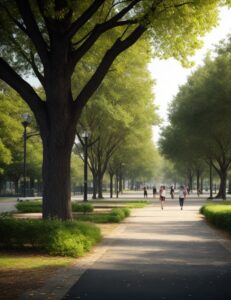Planning and Design
Local authorities take on the role of urban architects, envisioning parks that seamlessly blend with the existing urban fabric. This process begins with comprehensive analysis—studying the community’s needs, understanding the local demographics, and identifying suitable locations. They have to find that delicate balance between creating recreational areas and preserving natural habitats.
Urban planners collaborate with architects and environmental experts. The goal is to create spaces that cater to the diverse needs of our communities. Every tree, every bench, and every pond is strategically placed to enhance the park’s usability and beauty.
Local governments ensure that these green spaces are inclusive, and accessible to everyone regardless of age or physical ability. This means carefully designed pathways, ramps, and facilities, ensuring that every member of the community can enjoy the park without limitations.
Local governments collaborate with law enforcement agencies to design parks that deter anti-social activities and promote a sense of security. Well-lit areas, visible from various vantage points, discourage illicit activities, ensuring that the park remains a safe haven for families and individuals alike.
 Budgeting and Funding
Budgeting and Funding
Budgeting for urban park development is a meticulous process that involves crunching numbers, evaluating priorities, and making informed decisions. Local authorities meticulously allocate funds, considering aspects such as land acquisition, infrastructure development, landscaping, and ongoing maintenance. Each allocation is a strategic investment, carefully tailored to maximize impact while optimizing available resources.
Public funds, generated through taxes and other revenue streams, form the bedrock of park financing. These funds are meticulously managed, with a portion earmarked for green initiatives. Local authorities actively seek grants from governmental and non-governmental organizations. These grants serve as catalysts, enabling ambitious park projects to materialize.
Partnerships with private enterprises and philanthropic organizations also play a pivotal role in securing resources. Corporate sponsorships and collaborations with businesses lead to innovative initiatives. Philanthropic organizations extend their support, contributing significantly to the realization of park projects.
Local governments proactively involve citizens in fundraising efforts. Crowdfunding campaigns, donation drives, and community events become avenues for residents to actively participate in the creation of their green zones.
They implement rigorous financial management practices, constantly evaluating the efficiency of resource utilization. Regular audits and transparent reporting mechanisms are in place, ensuring accountability and fostering trust among citizens.
Community Engagement
Town hall meetings, community workshops, and online forums become platforms for dialogue. Residents express their aspirations, concerns, and visions for their neighborhoods. These conversations shape the park’s blueprint to align with the community’s unique needs.
Local governments focus on reaching out to diverse demographics within the community. They actively involve seniors, children, differently-abled individuals, and various cultural groups. Understanding the unique requirements of each demographic group is important.
Volunteer programs are initiated, inviting residents to contribute their time and energy toward park maintenance activities. Planting trees, organizing clean-up drives, or conducting educational workshops become collective efforts that reinforce community pride and ownership.
Local governments leverage technology to conduct surveys, enabling residents to vote on design elements or suggest new features. This digital interaction amplifies community participation, ensuring that a wider spectrum of voices is heard.
Environmental Sustainability
They prioritize indigenous flora that support local ecosystems. These plants are naturally adapted to the climate, requiring minimal water and maintenance. By choosing native species, local authorities conserve water resources and reduce the need for chemical pesticides, promoting a healthier environment for both humans and wildlife.
Local governments invest in innovative rainwater harvesting systems. Rainwater becomes a valuable resource. By collecting and storing rainwater, cities reduce reliance on scarce freshwater sources. This harvested water irrigates green spaces, ensuring that parks remain lush and vibrant even in arid regions.
LED lights, coupled with smart sensors, reduce energy consumption significantly. Local authorities adopt these technologies, as a commitment to reducing the city’s environmental impact.
Local governments designate protected areas within the city limits, ensuring that these spaces remain untouched by urban development. Wetlands, forests, and water bodies are safeguarded, allowing native flora and fauna to thrive.
They implement comprehensive recycling programs, encouraging citizens to segregate waste at the source. Recycling centers dot the urban space, making it convenient for residents to dispose of recyclables responsibly. By diverting waste from landfills, cities reduce their environmental impact and pave the way for a more sustainable future.
Maintenance and Preservation
They set up meticulous plans, outlining tasks ranging from landscape upkeep to playground safety inspections. Trained staff meticulously tend to the greenery, ensuring that trees are pruned, grass is trimmed, and flowerbeds bloom vibrantly. Regular maintenance fosters a healthy environment for both visitors and wildlife.
Local authorities deploy waste bins strategically, encouraging visitors to dispose of litter responsibly. Recycling initiatives are integrated, ensuring that recyclable waste is segregated and sent for processing.
They undertake restoration projects, preserving monuments, sculptures, and historical landmarks that lend character to the park. These preservation efforts educate visitors about the city’s history.
Local governments utilize smart sensors to monitor foot traffic, enabling them to identify high-use areas that require special attention. Irrigation systems are equipped with sensors that analyze soil moisture levels, ensuring that water is distributed efficiently, promoting the health of plants and conserving water resources.
Long-term strategies are developed to address challenges such as climate change and urbanization. Drought-resistant plant species are chosen, ensuring the park’s resilience in the face of changing weather patterns. Flood mitigation measures are integrated, safeguarding the park from potential natural disasters. Forward-thinking planning ensures that the park stands resilient against future challenges.
The role of local government in urban park development is multifaceted. It encompasses strategic planning, financial acumen, community engagement, environmental stewardship, and long-term preservation efforts. Through their dedicated work, local authorities transform barren lands into thriving green spaces, shaping the urban landscape and enriching the lives of the communities they serve.